by California Casualty | Behind the Scenes, Calcas Connection |
If you are looking for information or want to share a cool picture, California Casualty is there for you. We are striving to be more than just your insurance company – we want to be a valuable resource, too. Our online community offers interesting articles, captivating photos, tweets and links that reflect what you are thinking and doing.
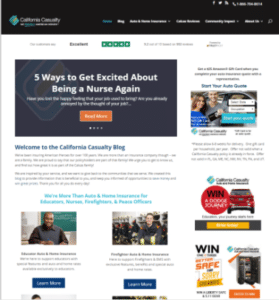 Head to the California Casualty blog (https://mycalcas.com/) for in-depth content and articles that pertain to your profession, information on how to get the most out of your insurance, and tips on how to protect your automobile and home. Some recent articles include “Five Ways to Get Excited About Being a Nurse Again,” “How to Make the Most of Your Summer Break Without Breaking the Bank,” and “Four Ways to Save with a Teen Driver.” Check back often to get a feel for what your peers and guest bloggers are writing and the ways that California Casualty supports you and your family.
Head to the California Casualty blog (https://mycalcas.com/) for in-depth content and articles that pertain to your profession, information on how to get the most out of your insurance, and tips on how to protect your automobile and home. Some recent articles include “Five Ways to Get Excited About Being a Nurse Again,” “How to Make the Most of Your Summer Break Without Breaking the Bank,” and “Four Ways to Save with a Teen Driver.” Check back often to get a feel for what your peers and guest bloggers are writing and the ways that California Casualty supports you and your family.
Follow us on twitter (https://twitter.com/CalCasInsurance) to see and share tips for the classroom, find captivating information and heroic acts of first responders, and read what’s on the minds of nurses and other healthcare professionals. You’ll also catch glimpses of how California Casualty honors and supports the men and women we serve.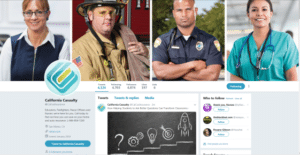
If you need a laugh, fabulous gift ideas or that perfect meme, take a peek at our Pinterest page (https://www.pinterest.com/CalCasInsurance). Re-pin something you’d like to share with others, or feel free to add a comment.
Instagram is another place to find fun pictures, a motivational quote or get updates on one of our giving programs for your occupation. It’s easy to do at https://www.instagram.com/CalCasInsurance. 
Our Facebook page is a collection of the many ways California Casualty embraces the professions you represent. Take a look, like a post, and share with others at https://www.facebook.com/CaliforniaCasualty.
If you like videos, tune into our YouTube channel (https://www.youtube.com/user/CalCasInsurance). You’ll see what California Casualty is all about, what makes us different, and watch heartwarming stories of those we serve. You can even learn a little more about the various insurance products we provide.
To manage your policies, make changes or find insurance for your expensive toys (boats, snowmobiles or motorcycles), visit the California Casualty corporate website (https://www.CalCas.com/). Logging in and creating an account gives you access to your policies at your convenience – anywhere, anytime. It’s a great place to send family members and colleagues who are looking for auto and home/renters insurance designed for their specific needs. There is also a careers page if you or someone you know wants to work for a company that protects American heroes.
Just like you, we are part of an online community looking for best practices, great stories and captivating photos. Take advantage of what others have contributed, and offer your opinion, pictures and stories through whichever online platform you prefer. We are there to help you exchange ideas with others who share your interests.
TAKEAWAY: Visit https://mycalcas.com to begin your informational tour with California Casualty. You’ll find interesting articles and links to the many other online platforms where you can connect and engage with others.
Read all the articles from the this edition of the Calcas Connection Newsletter:
Get Your Ride Ready For Summer
Boat Insurance Keeps You Afloat
Celebrating What You Do
by California Casualty | News |
 California Casualty Customer Care Specialist Darrah Z. recently received an unusual request from Union High School (Evergreen School District – Washington) Math Teacher and long-term customer Jeanie Langley. “Jeanie sent me an email asking about an expert who could teach insurance fundamentals to her students,” said Darrah. Darrah sent Jeanie’s request to the Partner Relations Team for a follow-up to find out what California Casualty could do to help. It turns out that Jeanie wanted to mix it up a bit in her Financial Literacy senior class. “My students were losing interest, and I needed to do something to bring them back around,” Jeanie told us. “They are about to be real-life adults, so this is serious! I wanted to invite specialists in as guest speakers.” On different days, Jeanie had representatives from a car dealership, a local credit union, an apartment landlord organization, colleges, and health and life insurance agents come in to speak to her seniors. Ultimately, Darrah connected Jeanie with Erica Reich, a California Casualty Field Marketing Manager in Washington. Erica immediately jumped on board and agreed to take the lead role in Jeanie’s “Auto Insurance” module within Union High School’s Financial Literacy class.
California Casualty Customer Care Specialist Darrah Z. recently received an unusual request from Union High School (Evergreen School District – Washington) Math Teacher and long-term customer Jeanie Langley. “Jeanie sent me an email asking about an expert who could teach insurance fundamentals to her students,” said Darrah. Darrah sent Jeanie’s request to the Partner Relations Team for a follow-up to find out what California Casualty could do to help. It turns out that Jeanie wanted to mix it up a bit in her Financial Literacy senior class. “My students were losing interest, and I needed to do something to bring them back around,” Jeanie told us. “They are about to be real-life adults, so this is serious! I wanted to invite specialists in as guest speakers.” On different days, Jeanie had representatives from a car dealership, a local credit union, an apartment landlord organization, colleges, and health and life insurance agents come in to speak to her seniors. Ultimately, Darrah connected Jeanie with Erica Reich, a California Casualty Field Marketing Manager in Washington. Erica immediately jumped on board and agreed to take the lead role in Jeanie’s “Auto Insurance” module within Union High School’s Financial Literacy class.
Erica arrived at Union HS bright and early with a flash drive, and clicker in hand prepared to talk through a 45-minute presentation she developed with her Team Manager Brian Goodman. “Jeanie told me beforehand that this group of students can be inattentive,” Erica added. “So that’s why I brought a few ‘Distracted Driving Kills’ Impact Teen Driver t-shirts with me as prizes… I was tossing them out to the kids right away if they engaged with me.” It didn’t take long before the students were learning the difference between liability insurance, collision and comprehensive coverage, transportation, uninsured motorist, PIP, and towing options. “We taught them how to read a Declarations Page! It was a lot of fun and felt like the right thing to do,” Erica said.
“It didn’t take long for the word to get out,” said TM Brian. “She did such a great job connecting with the students.” A few days after her presentation, Erica received an email from fellow Evergreen SD teacher Allison Wallace. Allison teaches Personal Finance at neighboring He La High School. She heard about the class Erica taught for her friend Jeanie. Allison asked Erica if she would be willing to bring her expertise to her classroom, as well. Allison said, “My students have to learn to budget living expenses, investments, insurance, and credit cards. So now, Erica will be teaching two separate Personal Finance auto insurance modules. Brian added, “Word spreads quickly! Erica is volunteering her time to help kids which is worth it right there. And she is showing Evergreen High School educators the spirit of what California Casualty is all about. It’s more than providing auto and home insurance coverage – it’s our dedication to supporting and building long-lasting relationships with NEA members at all levels that truly sets California Casualty apart.”
As Erica was leaving the class at the end of the first presentation, customer Jeanie Langley told her, “I’m going home to look at my California Casualty Dec Page!”
by California Casualty | Calcas Connection, In Your Community |
California Casualty supports the many groups we work with in a variety of ways.
 Recently, Partner Relations team members Brian Goodman and Tami Phillips paid a special visit to the Sonoma County Deputy Sheriff’s Association. They presented a token of our appreciation for the group’s heroic efforts during the disastrous fires that struck in October 2017. The deputies not only put their lives on the line for others, but also opened their facility to help coordinate firefighting and support efforts. SCDSA President Mike Vail accepted the plaque for all of the members of the association. A similar presentation was made at the Marin County Deputy Sheriff’s Association.
Recently, Partner Relations team members Brian Goodman and Tami Phillips paid a special visit to the Sonoma County Deputy Sheriff’s Association. They presented a token of our appreciation for the group’s heroic efforts during the disastrous fires that struck in October 2017. The deputies not only put their lives on the line for others, but also opened their facility to help coordinate firefighting and support efforts. SCDSA President Mike Vail accepted the plaque for all of the members of the association. A similar presentation was made at the Marin County Deputy Sheriff’s Association.
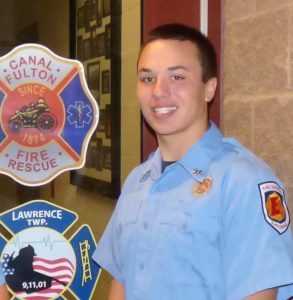 Another program California Casualty is proud to sponsor is the National Volunteer Fire Council’s Junior Firefighter of the Year and Junior Firefighter Program of the Year awards.
Another program California Casualty is proud to sponsor is the National Volunteer Fire Council’s Junior Firefighter of the Year and Junior Firefighter Program of the Year awards.
Please join us in congratulating the winners: Jared Hagen, of the Northwest Fire Explorer Post 1854 in Ohio, is the 2018 Junior Firefighter of the Year, and the 2018 Junior Firefighter Program of the Year is being given to North Carolina’s Gaston Volunteer Fire Department Junior Firefighter Program. They will be formally honored April 20.
In addition, California Casualty has given athletics grants to public schools since 2011. This year, student-athletes at 79 public middle schools and high schools in 32 states will enjoy a more level playing field thanks to the 2018 California Casualty Thomas R. Brown Athletics Grant Program.
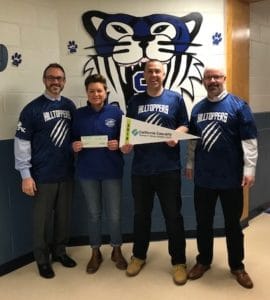 Pictured L to R: California Casualty’s Scott McKenna presenting a Thomas R. Brown Athletics Grant to Somersworth Middle School softball coach Kaley Waterman, Principal Dana Hilliard with NEA New Hampshire representative Jeff Kantorowski.
Pictured L to R: California Casualty’s Scott McKenna presenting a Thomas R. Brown Athletics Grant to Somersworth Middle School softball coach Kaley Waterman, Principal Dana Hilliard with NEA New Hampshire representative Jeff Kantorowski.
Grants totaling just over $83,000 are going to help sports programs impacted by diminishing resources and budget cuts. Some examples include:
- Purchasing a tackling and blocking sled to improve safety for the Crosby High School (Connecticut) football team
- Outfitting the Somersworth Middle School (New Hampshire) softball team with new uniforms
- Providing soccer and track and field equipment for the Santan Junior High School (Arizona) ADAPTS sports program for autistic students
- Supplying balls and basic equipment for the Matt Garcia Career and College Academy (California) volleyball and basketball teams
More than $660,000 has been awarded to some 600 schools across the nation since the program began.
TAKEAWAY:
Learn more about the many ways California Casualty gives back to the individuals and groups that we serve by visiting www.calcas.com/newsroom.
Read all the articles from this edition of the Calcas Connection Newsletter:
by California Casualty | Behind the Scenes, Calcas Connection |
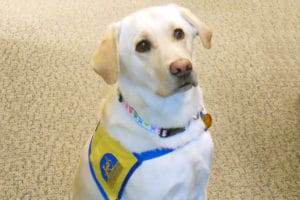 Their little paws and happy faces have graced California Casualty for close to 15 years. They are the service dogs who temporarily call California Casualty home before heading off to become service animals for those with various disabilities.
Their little paws and happy faces have graced California Casualty for close to 15 years. They are the service dogs who temporarily call California Casualty home before heading off to become service animals for those with various disabilities.
Three of our employees are puppy trainers for Canine Companions for Independence, a nonprofit that provides service dogs for adults with physical disabilities, hearing issues, physical, cognitive and development disabilities, or for therapy in a visitation, education or healthcare setting.
If you have a pet-friend at home or work, you know how much joy and fun they bring. That’s how it is at California Casualty.
Each dog spends the first year-and-a-half of their life with a trainer getting socialized, learning commands and dealing with distractions. California Casualty, with a large number of employees with varying schedules and personalities, is the perfect place for their education, and the company encourages it.
While there have been as many as four pups roaming our hallways, there is currently only one – Darien, being raised and trained by Mary, one of our claims representatives. Darien is a year-old golden lab. He’s the 18th puppy that Mary has taken in.
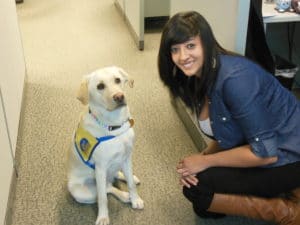
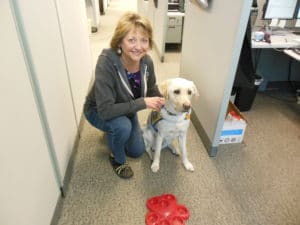 She and her husband share a love of animals and a desire to give back to the community. Canine Companions was the perfect way to fit volunteering into their busy schedules.
She and her husband share a love of animals and a desire to give back to the community. Canine Companions was the perfect way to fit volunteering into their busy schedules.
The training has left a permanent bond between Mary and the pups. Mary keeps in touch with every dog, and each one remembers her when she visits, even a decade later.
Many people at work can’t wait to play with and puppy-sit Darien. One of those is Jasmine, who is convinced that spending time with Darien helps her as much as it helps him. “Darien makes me happy and makes my day go better,” she said.
Mary said that Darien is so popular that she often has to search to find where he has gone at various times of the day. “I know that many of my co-workers think Darien is a therapy dog for them, reducing stress and bringing joy to their day. They often come to my desk to give him pets when they are having a challenging day, saying how much it helps.”
Karen, the manager of our Learning and Development department, is another volunteer for Canine Companions. While raising puppies to go to others takes an emotional toll, she said it’s worth it knowing the joy and independence they give to those with physical disabilities.
We love the dogs that are fostered within our company walls, and we look forward to the pitter-patter of little paws and the boundless love when new ones arrive.
TAKEAWAY:
Learn more about Canine Companions and their dedication to helping others at www.CCI.org.
Read all the articles from this edition of the Calcas Connection Newsletter:
by California Casualty | Calcas Connection, In Your Community, News |
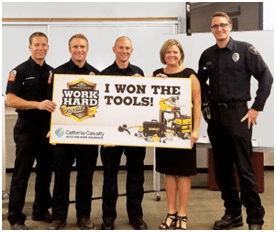 We realize how dedicated you are to making your communities better places. That’s why California Casualty created giving initiatives to say thanks to the members of the affinity groups with whom we work.
We realize how dedicated you are to making your communities better places. That’s why California Casualty created giving initiatives to say thanks to the members of the affinity groups with whom we work.
Recently, Tucson fire captain Max S. was the recipient of a $5,000 Work Hard/ Play Hard “Choose Your Tools” award from California Casualty. The contest recognized the dangerous work first responders do. Max loved the prize because it’s a gift that will last him a lifetime. “I appreciate California Casualty for understanding how hard firefighters work,” he said.
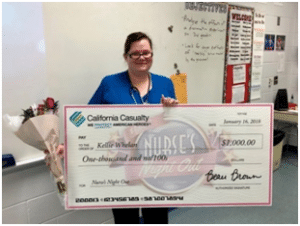 And New Jersey RN Kellie W., a policyholder herself, started the New Year with a $1,000 Nurses Night Out award from California Casualty. Kellie, a school nurse and a member of the New Jersey Education Association, said, “I was so surprised and honored to receive this prize from California Casualty.”
And New Jersey RN Kellie W., a policyholder herself, started the New Year with a $1,000 Nurses Night Out award from California Casualty. Kellie, a school nurse and a member of the New Jersey Education Association, said, “I was so surprised and honored to receive this prize from California Casualty.”
The Nurses Night Out award was created to thank nurses and nurse practitioners for all they do to keep their communities healthy. The winners can use the $1,000 in any way they wish: hosting a party, a relaxing day at the spa, or taking a much-needed vacation.
Nurse Kellie plans on using the funds for a summer tour of the national parks with her family, but will also treat teachers and staff at the school to a breakfast in the near future.
“California Casualty protects American heroes and we want to show our support to the men and women who take care of America,” emphasized Mike McCormick, California Casualty Sr. Vice President.
TAKEAWAY:
Learn more about the many ways California Casualty gives back to the individuals and groups that we serve by visiting www.calcas.com/newsroom.
Read all the articles from this edition of the Calcas Connection Newsletter:
 Head to the California Casualty blog (https://mycalcas.com/) for in-depth content and articles that pertain to your profession, information on how to get the most out of your insurance, and tips on how to protect your automobile and home. Some recent articles include “Five Ways to Get Excited About Being a Nurse Again,” “How to Make the Most of Your Summer Break Without Breaking the Bank,” and “Four Ways to Save with a Teen Driver.” Check back often to get a feel for what your peers and guest bloggers are writing and the ways that California Casualty supports you and your family.
Head to the California Casualty blog (https://mycalcas.com/) for in-depth content and articles that pertain to your profession, information on how to get the most out of your insurance, and tips on how to protect your automobile and home. Some recent articles include “Five Ways to Get Excited About Being a Nurse Again,” “How to Make the Most of Your Summer Break Without Breaking the Bank,” and “Four Ways to Save with a Teen Driver.” Check back often to get a feel for what your peers and guest bloggers are writing and the ways that California Casualty supports you and your family.


 California Casualty Customer Care Specialist Darrah Z. recently received an unusual request from Union High School (Evergreen School District – Washington) Math Teacher and long-term customer Jeanie Langley. “Jeanie sent me an email asking about an expert who could teach insurance fundamentals to her students,” said Darrah. Darrah sent Jeanie’s request to the Partner Relations Team for a follow-up to find out what California Casualty could do to help. It turns out that Jeanie wanted to mix it up a bit in her Financial Literacy senior class. “My students were losing interest, and I needed to do something to bring them back around,” Jeanie told us. “They are about to be real-life adults, so this is serious! I wanted to invite specialists in as guest speakers.” On different days, Jeanie had representatives from a car dealership, a local credit union, an apartment landlord organization, colleges, and health and life insurance agents come in to speak to her seniors. Ultimately, Darrah connected Jeanie with Erica Reich, a California Casualty Field Marketing Manager in Washington. Erica immediately jumped on board and agreed to take the lead role in Jeanie’s “Auto Insurance” module within Union High School’s Financial Literacy class.
California Casualty Customer Care Specialist Darrah Z. recently received an unusual request from Union High School (Evergreen School District – Washington) Math Teacher and long-term customer Jeanie Langley. “Jeanie sent me an email asking about an expert who could teach insurance fundamentals to her students,” said Darrah. Darrah sent Jeanie’s request to the Partner Relations Team for a follow-up to find out what California Casualty could do to help. It turns out that Jeanie wanted to mix it up a bit in her Financial Literacy senior class. “My students were losing interest, and I needed to do something to bring them back around,” Jeanie told us. “They are about to be real-life adults, so this is serious! I wanted to invite specialists in as guest speakers.” On different days, Jeanie had representatives from a car dealership, a local credit union, an apartment landlord organization, colleges, and health and life insurance agents come in to speak to her seniors. Ultimately, Darrah connected Jeanie with Erica Reich, a California Casualty Field Marketing Manager in Washington. Erica immediately jumped on board and agreed to take the lead role in Jeanie’s “Auto Insurance” module within Union High School’s Financial Literacy class. Recently, Partner Relations team members Brian Goodman and Tami Phillips paid a special visit to the Sonoma County Deputy Sheriff’s Association. They presented a token of our appreciation for the group’s heroic efforts during the disastrous fires that struck in October 2017. The deputies not only put their lives on the line for others, but also opened their facility to help coordinate firefighting and support efforts. SCDSA President Mike Vail accepted the plaque for all of the members of the association. A similar presentation was made at the Marin County Deputy Sheriff’s Association.
Recently, Partner Relations team members Brian Goodman and Tami Phillips paid a special visit to the Sonoma County Deputy Sheriff’s Association. They presented a token of our appreciation for the group’s heroic efforts during the disastrous fires that struck in October 2017. The deputies not only put their lives on the line for others, but also opened their facility to help coordinate firefighting and support efforts. SCDSA President Mike Vail accepted the plaque for all of the members of the association. A similar presentation was made at the Marin County Deputy Sheriff’s Association. Another program California Casualty is proud to sponsor is the
Another program California Casualty is proud to sponsor is the  Pictured L to R: California Casualty’s Scott McKenna presenting a Thomas R. Brown Athletics Grant to Somersworth Middle School softball coach Kaley Waterman, Principal Dana Hilliard with NEA New Hampshire representative Jeff Kantorowski.
Pictured L to R: California Casualty’s Scott McKenna presenting a Thomas R. Brown Athletics Grant to Somersworth Middle School softball coach Kaley Waterman, Principal Dana Hilliard with NEA New Hampshire representative Jeff Kantorowski. Their little paws and happy faces have graced California Casualty for close to 15 years. They are the service dogs who temporarily call California Casualty home before heading off to become service animals for those with various disabilities.
Their little paws and happy faces have graced California Casualty for close to 15 years. They are the service dogs who temporarily call California Casualty home before heading off to become service animals for those with various disabilities.
 She and her husband share a love of animals and a desire to give back to the community. Canine Companions was the perfect way to fit volunteering into their busy schedules.
She and her husband share a love of animals and a desire to give back to the community. Canine Companions was the perfect way to fit volunteering into their busy schedules. We realize how dedicated you are to making your communities better places. That’s why California Casualty created giving initiatives to say thanks to the members of the affinity groups with whom we work.
We realize how dedicated you are to making your communities better places. That’s why California Casualty created giving initiatives to say thanks to the members of the affinity groups with whom we work. And New Jersey RN Kellie W., a policyholder herself, started the New Year with a $1,000 Nurses Night Out award from California Casualty. Kellie, a school nurse and a member of the New Jersey Education Association, said, “I was so surprised and honored to receive this prize from California Casualty.”
And New Jersey RN Kellie W., a policyholder herself, started the New Year with a $1,000 Nurses Night Out award from California Casualty. Kellie, a school nurse and a member of the New Jersey Education Association, said, “I was so surprised and honored to receive this prize from California Casualty.”